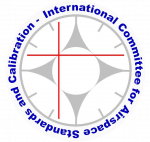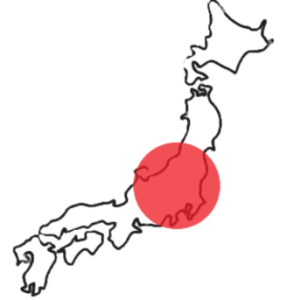Germany
The History of Flight Inspection in Germany
Flight Inspection in Germany has undergone a large number of changes throughout the decades with respect to flight inspection aircraft, technology and organization.
Flight Inspection in the Bundesanstalt für Flugsicherung (BFS) from 1953 to 1976
In response to a task assigned to BFS (Federal Administration of Air Navigation Services, founded on 1 July 1953) to ensure the operational readiness of all navigation systems a “Calibration and Test Unit” (MVS) was set up. A light aircraft was soon purchased from a Swiss advertising company and equipped with test equipment. In 1954 and 1955, BFS purchased a four-engine Handley Page Marathon and a twin-engined De Havilland Dove aircraft. These were initially registered in Great Britain and had British crews until BFS became the aircrafts’ owner and the aircraft were manned by German crews after Germany regained its sovereignty over its airspace.
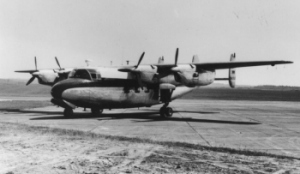 Handley Page H.P.R.1 Marathon
Handley Page H.P.R.1 Marathon
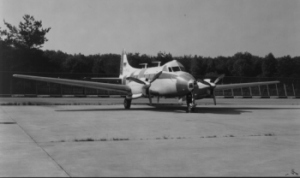 De Havilland DH.104 Dove
De Havilland DH.104 Dove
The unit transferred to Frankfurt airport in March 1955, located in a building close to today’s Terminal 2. At that time, flight inspection equipment was not commercially available. Therefore, the unit’s own development department was in charge of developing all measuring and calibration equipment, using commercially available components and adapting them for flight inspection purposes. After decommissioning the Marathon due to increasing technical issues, two further De Havilland Doves were purchased in 1962 and 1963, increasing the fleet size to three aircraft. The few radar flight inspections necessary for the small number of radar systems operational at the time were carried out by jet aircraft of the German Armed Forces or by chartered business jets. With the advent of all-weather CAT II operations in the 1960s, and later CAT III, accuracy requirements for flight inspection measuring equipment substantially increased. As at that time, flight inspection equipment was large and heavy and as the Dove calibration aircraft was already operating close to its maximum weight limits, a new, larger aircraft was needed. BFS purchased two Hawker Siddeley HS.748s in 1969 and 1972. These aircraft were also better suited for the more economical inspection of several en-route navigation facilities in a single flight, applying new measuring methods.
Flight Inspection in the German Air Force
The German Air Force (GAF), operating a number of ground-based navigation aids, formed their own Flight Inspection 612 Squadron in Kaufbeuren in Southern Germany which started operations in August 1958 with six Percival Pembroke C.Mk.54 aircraft. Apart from flight inspection tasks the squadron also carried out electronic warfare (Eloka) activities. It sub¬sequently formed the core of the Communications Training and Test Regiment 61, formed on March 23rd, 1961 in Lechfeld. The squadron was eventually equipped with modified Do-27, C-47D Skytrain and N.2501D Noratlas aircraft to respond to additional navigation systems and extension of Eloka flights with their new technical requirements. The squadron’s size further expanded in 1961 to 1965, to finally encompass 10 Pembroke C.Mk.54 aircraft and 13 Douglas C-47Ds. Further tasks assigned to the flight inspection squadron from June 1962 for the next eight years covered training of Starfighter pilots and involved conversions and radar modifications of four C-47Ds and one C-53DO as trainers. After integration of the flight command of the Air Forces’ engineering academy on 1 April 1970, the Communications Training and Test Regiment 61 had two flying squadrons – the 4th squadron for flight inspection in Lechfeld and the 7th squadron as a flight operations unit in Kaufbeuren. When the last C-47D was decommissioned 14 April 1976, the 4th squadron shut down its flight inspection operations, marking the era of the beginning civil-military co-operation. The squadron had logged a total of 44,251 flying hours and 4,700 inspection flights when it closed down 26 March 1976.
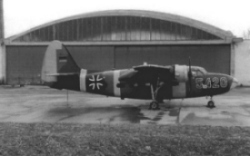 Percival Pembroke C.Mk.54
Percival Pembroke C.Mk.54
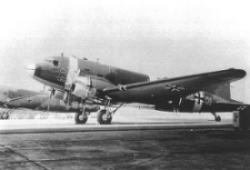 Douglas C-47D Skytrain
Douglas C-47D Skytrain
Transition to Civil-Military Co-operation in Flight Inspection - the Joint Flight Inspection Unit (GFMS).
Booming air traffic in the 1970s made finding pilots for the new BFS aircraft difficult. As part of the emerging civil-military co-operation the German Air Force (GAF) agreed to provide DFS with pilots as an inter¬departemental support. Military pilots thus performed flight inspection operations from 1971 onwards. As the aging GAF flight inspection aircraft were due for replacement, DFS and GAF began discussions on a joint execution of military and civil fight inspection for all German civil and military air navigation facilities. This culminated in an agreement signed on June 30th, 1972 between the Federal Ministers of Transport and Defense. According to this, the new organization would be called “Gemein¬same Flugvermessungsstelle” – GFMS (Joint Flight Inspection Unit). Whilst BFS was the holder of the aircraft and responsible for their maintenance, flight operations was under control of the Air Force. Construction works for new buildings including two aircraft hangars, workshops, laboratories and a power station at the military airfield of Lechfeld started in 1974. GFMS operations finally began on 1 November, 1976, a few months after the final ratification of the agreement on 9 July, 1976. The merging of the two flight inspection services led to a large increase of the fleet size following the purchase of five HS.748 in 1976 and one Hawker-Siddeley HS.125 jet to respond to the increasing demand for radar flight testing. The GFMS fleet thus reached a maximum size of seven HS.748, two Doves – used until into the 1980s – , and the HS.125 jet.
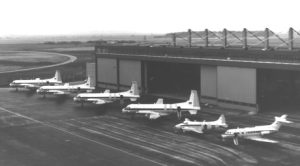 Hangar with calibration aircraft at the Air Force Base Lagerlechfeld
Hangar with calibration aircraft at the Air Force Base Lagerlechfeld
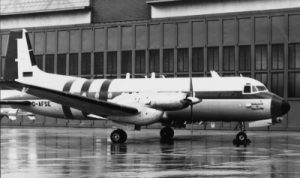 Hawker Siddeley HS.748 Srs 2 D-AFSF
Hawker Siddeley HS.748 Srs 2 D-AFSF
Merging of Flight Inspection Services of BFS and Interflug (GDR).
The unique political event of German re-unification led to a new organizational challenge. Flight inspection in East Germany had been carried out by Interflug in Dresden operating an Iljushin IL-18W calibration aircraft, the largest aircraft ever used in Germany for flight inspection, supported by the Technical Testing and Flight Inspection (TPFS) unit. Following first contacts by BFS in 1990 with Interflug and TPFS it was soon decided to close down the East German operations and to assign the task of calibrating East German Navaids to GFMS.
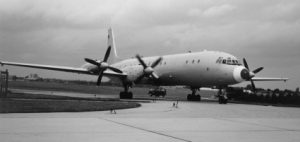 Iljushin IL-18W
Iljushin IL-18W
Summary of Flight Inspection by the BFS Government
By 1993, GFMS had clocked up 100,000 flying hours since the foundation of the civil and military flight inspection services. By the time the HS.125 and HS.748 aircraft were sold, they had accumulated a total of almost 60,000 flying hours. In this period, there was only a single accident with material damage. This occurred in Düsseldorf when a flare-out of both engines during an approach due to air inlet icing put the HS.125 out of action for three months. The GFMS joint civil-military co-operation turned out be a highly successful operation, in a period where such cooperation in other fields in Germany was still unthinkable and many decades before civil and military flight inspection units in other countries even considered merging. GFMS had gained international reputation due to its innovative solutions in flight inspection technology and was frequently consulted by other organizations with respect to setting up or optimizing operations. Efficiency improvement was nothing new for GFMS, although this frequently required employees to adapt to new processes and constraints due to organizational changes in the 1980s.
Reorganization of Flight Inspection by DFS Deutsche Flugsicherung GmbH - DFMG
On 1 January 1993, the air navigation services in Germany (BFS) was corporatized and all responsibility assumed by DFS Deutsche Flugsicherung GmbH. This change allowed DFS to launch a critical project to radically reorganize the former BFS flight inspection operations. The aim was to streamline operations by using smaller aircraft and the now commercially available flight inspection equipment, among other measures, in order to bring pricing down to a competitive level. A reorganization plan was created by a task force created by the DFS Board of Directors in 1993. Two Beechcraft King Air 350 were purchased a year later and equipped with new Aerodata flight inspection systems, already tried and tested in the HS.748s. Simultaneously, a new subsidiary was founded under private law named DFMG Deutsche Flugmessgesellschaft mbH. The operations was then transferred from the previous base in Lechfeld to Braunschweig, the location of DFMG’s new partner, Aerodata AG in 1996. The old HS.748 aircraft were subsequently decommissioned and sold. The results of this reorganization was a dramatic reduction of the cost of flight inspection as a direct result of downsizing to smaller aircraft, a much smaller fleet size, modern flight inspection equipment, more efficient procedures, outsourcing aircraft maintenance and a corresponding reduction of the staff count.
1997 -2001 FII Flight Inspection International GmbH - a Trinational Joint Flight Inspection Operations
On 1 October 1997, the Swiss ANSP swisscontrol became a new DFMG shareholder after the decision to close down its own flight inspection unit. DFMG was renamed to FII Flight Inspection International GmbH, in line with its increasingly international profile. On 1 January 1998, the Austrian ANSP, Austro Control also decided to follow the swisscontrol example and became a further shareholder of FII. FII was a highly economic operations and provided flight inspection services not only for Germany, Switzerland and Austria, but also for the Netherlands, Luxemburg, Spain, Macedonia, Lithuania, and Middle East countries such as Kuwait, Yemen, Sudan and Egypt. With the expansion of FII’s international business, a fourth King Air 350 was purchased in 2009 and equipped with an Aerodata flight inspection system. This aircraft was lost in a tragic CFIT accident in southern Germany in September 2000, killing all four crew members. The BFU accident investigation report would later identify spatial disorientation in combination with the use of information from the flight inspection system for navigation purposes in IFR conditions contrary to procedures, as the main contributing factors to this tragedy.
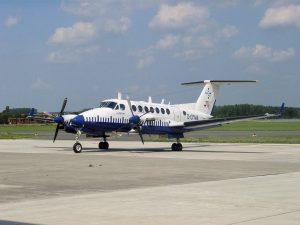 Beechcraft King Air B350 D-CFMA
Beechcraft King Air B350 D-CFMA
The Last Decade 2001 to 2011
In mid-2001 FII was split up into two companies: FCS Flight Calibration Services GmbH, the legal successor of FII, and Aerodata Flight Inspection. FCS was to carry out flight inspection for its ANSP shareholders in Germany, Austria and Switzerland as well as all Germany military flight inspection. Aerodata Flight Inspection operated its D-CACB King Air 350 aircraft to service FII’s international contracts as well as German regional airports. Today, both FCS and Aerodata Flight Inspection, the latter now merged into Cobham Flight Inspection, have approvals to perform flight inspection in Germany from the new Federal Supervisory Authority for Air Navigation Services (BAF), which was established in 2010.
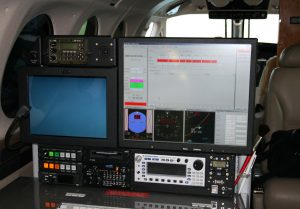 Flight Inspection equipment on board B350 King Air D-CFMD
Flight Inspection equipment on board B350 King Air D-CFMD
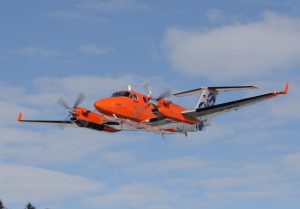 Beechcraft King Air B350 D-CFME
Beechcraft King Air B350 D-CFME
Photo credits: BFS, German Air Force, FCS, H.-J. Kunze, C.-A. Fauser
